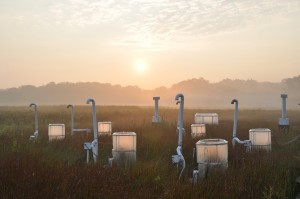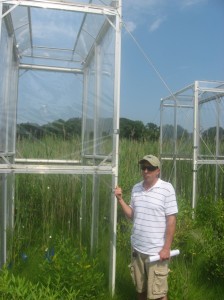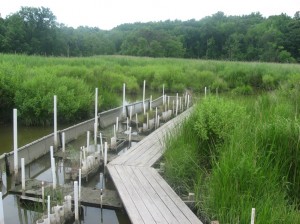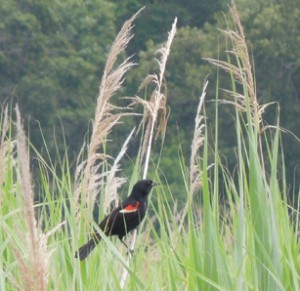By Katie Sinclair
If you take a stroll out along the green grated catwalk that lies several feet above the muddy marsh ground at SERC, the first thing you’ll notice is strange white structures dotting the lush landscape. No, the aliens haven’t landed. These white enclosures make up several experiments at SERC. The goal of each experiment is to determine how a changing climate will affect this valuable marsh habitat, which stores carbon, has high primary productivity, and provides homes for fish, crustaceans, insects, and more.

The SERC marsh. Under each capsule, conditions are set to mimic the CO2 concentration expected in 2100.
( Thomas Mozdzer)
Carbon and Nitrogen: Elements of Growth
Since 1987, SERC scientists have been pumping CO2 into these plastic chambers to simulate the marsh a century from now—a marsh in the grip of climate change. Inside these miniature time capsules, marsh plants grow with 350 parts per million more CO2 than is in the atmosphere today, levels scientists expect to see by the year 2100. As marsh plants grow, they take in CO2 from the air. This carbon can either end up sequestered in the soil or released back into the ecosystem through decomposition. The CO2 addition experiments conducted at SERC are the longest-running in the world.
Besides carbon, marshes also rely on nitrogen, an element necessary for the creation of proteins. Due to runoff from fertilizers, nitrogen levels are also increasing in estuaries like the Cheasapeake Bay. As the concentration of both CO2 and nitrogen increases, scientists at SERC are asking important questions about how the structure of the marsh will be affected, including how it will change the plant communities that will grow there.
There are two types of plants in the marsh: sedges (Schenoplectus americanus), which are C3 plants, and grasses (Spartina patens), which are C4 plants. C3 and C4 plants differ in the mechanism by which they use carbon from CO2 to make sugars. The high CO2 levels help the C3 plants grow better, but do not help the C4 plant. But in high nitrogen environments, the C4 plants flourish while the C3 plants do just a little better. The different responses of each plant to increased levels of carbon and nitrogen helps explain why neither species has become dominant over the course of this long running experiment.
Phragmites and a Warming World

Pat Megonigal, Principal investigator of the Biogeochemsitry Lab and Deputy Director of SERC, stands next to an experiment to measure how fast invasive Phragmites displaces native species. Phragmites can grow to be 20 ft tall.
Addition of nitrogen and carbon has an especially big impact on the growth of Phragmites australis, an invasive plant that is taking over marshes. With increased carbon and nitrogen, Phragmites growth rates increase dramatically. Large enclosures over 10 feet high exposed to increased concentrations of carbon and nitrogen are testing the idea that Phragmites may be able to displace native species much faster in a near-future environment. However, increased Phragmites growth is not all bad news: While Phragmites does not provide the same type of habitat for wildlife as native grasses and sedges, Phragmites may help the marsh rise faster in elevation, which would make it less vulnerable to sea level rise. Phragmites’ long roots allow it to access nutrients buried deep in the soil, and fast root growth adds elevation to the soil surface.
Marsh Growth vs. Sea Level Rise
Marsh cores show that the marsh has existed for the past 5000 years, first emerging when sea level rise tapered off after the glaciers melted. Now that sea levels are rising again, the big question facing the SERC marsh is whether or not the increased growth from higher carbon in the atmosphere will keep pace with sea level rise.
Several factors determine whether a marsh rises or sinks. Above-ground plant growth leads to retention of mineral sediments, creating more solid substrate. Increased microbial activity leads to more decomposition of soil organic matter, which can lead to marsh collapse.
The inherently unstable marsh surface means that measuring marsh height requires a bit more effort than a yardstick-wielding scientist unafraid to get muddy. Measuring marsh height involves a stainless steel rod drilled 5 meters down into the marsh, where it hits the more solid clay layer, leaving about a half meter sticking out. A long metal arm attached to the top of the rod stretches across the marsh, from which fiberglass pins are used to make precise measurements of marsh height. By comparing the height of the marsh outside the experimental chamber to the height inside, researchers can see how much each treatment impacts the marsh level.
The good news is that increased plant growth due to more carbon in the atmosphere means that our marsh has a chance at surviving sea level rise, although the incursion of Phragmites and changes in species composition could mean that the marsh in 100 years could look quite different from the one today.
What’s Next?
Besides the long-term experiments looking at sea level rise, carbon and nitrogen addition, and Phragmites, other projects are looking at the marsh at a finer scale. Genotyping Phragmites can give a more complete picture of how this plant spreads and functions. Studies looking at the different ways that carbon from C3 and C4 plants are cycled can lead to a more complete picture of how nutrients make their way through the system.
Research at the SERC marsh is giving us insight into how a changing climate will impact ecosystems. By studying nutrient influx, growth, individual species, and the marsh surface rise, researchers are able to better understand what makes this vital habitat function.



